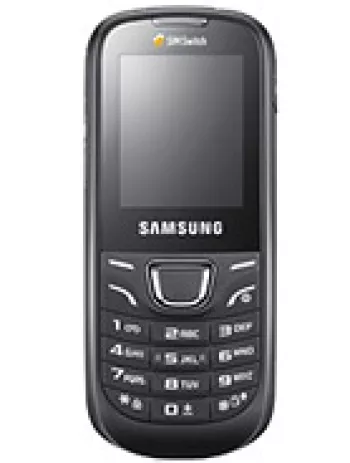
Overview of Samsung T139
The Samsung T139, released in February 2010, was a simple yet efficient feature phone that served the basic communication needs of users at a time when smartphones were beginning to gain popularity. Despite its limited functionalities compared to modern phones, the T139 was still considered a practical choice for those who sought a reliable device primarily for calls and messaging.
Design and Build
With dimensions of 95 x 48 x 18.3 mm and weighing only 84.5 grams, the Samsung T139 was designed to be compact and lightweight. Its body allowed for a comfortable grip, making it easy to use with one hand. The device utilized a classic clamshell design, which was popular at the time, protecting the screen when closed and prevent accidental dials or hang-ups.
Display Features
The phone came with a 1.4-inch TFT screen that supported 65K colors, offering a resolution of 128 x 160 pixels. While the screen size and resolution might seem small by today's standards, it was more than sufficient for displaying menus, messages, and basic graphics necessary for its operation.
Camera Capabilities
The Samsung T139 was equipped with a basic VGA camera with a 0.3MP resolution. Though it lacked the capability for video recording, the camera was adequate for capturing simple photographs. This feature was considered a bonus for a feature phone, offering users the ability to take photos on the go.
Battery Life
One of the strong points of the Samsung T139 was its reliable battery life. The device housed a removable Li-Ion 800 mAh battery, which could provide up to 300 hours of standby time and up to 6 hours of talk time. This made it an ideal choice for users who needed a phone with long-lasting battery performance.
Hardware Specifications
Internally, the device included 10MB of storage with no option for expansion via a card slot. It could store 300 contacts and keep a record of 30 received, dialed, and missed calls. Though lacking a powerful processor and RAM found in more advanced phones, the T139 was optimized for its limited functionalities, providing smooth performance for its intended use.
Connectivity and Network
The phone supported GSM technology on 850 and 1900 MHz bands, ensuring a broad network coverage for voice communication. However, data capabilities were limited to Class 10 GPRS, with no EDGE support, meaning that internet browsing was minimal through the WAP 2.0/xHTML browser.
Multimedia and Entertainment
The Samsung T139 offered basic entertainment options. Users could enjoy built-in games, and the device supported Java MIDP 2.0, allowing the installation of simple Java-based applications and games. However, it lacked advanced multimedia features such as music playback, as there was no headphone jack available.
Messaging and Browser
The messaging capabilities included SMS and MMS, allowing users to send text and multimedia messages. The browser was limited to WAP 2.0/xHTML, which restricted browsing to very basic web pages due to the lack of advanced connectivity options.
Bluetooth and USB Connectivity
For wireless communication, the device was equipped with Bluetooth 2.0, permitting file transfers between compatible devices. However, it did not support USB connectivity, which limited its usefulness in terms of data management with PCs or other devices.
Discontinuation and Legacy
By today's standards, the Samsung T139 might seem outdated and lacking in features. However, at the time of its release, it provided an affordable solution for basic communication needs and saw widespread use among consumers looking for reliability over modern functionality. Though the phone has since been discontinued, its simplicity and durability left a lasting impression on its users.
Concluding Thoughts
The Samsung T139's compact design, reliable battery life, and straightforward functionality made it a valuable addition to the lineup of feature phones in the early 2010s. While it may not meet the needs of tech-savvy users today, it serves as a reminder of an era when phones were primarily about staying connected through calls and texts.
Key Features of Samsung T139
- Lightweight design with 84.5 g (2.96 oz)
- Compact dimensions: 95 x 48 x 18.3 mm
- GSM technology supporting GSM 850 / 1900 bands
- Bluetooth 2.0 for wireless connectivity
- VGA main camera for basic photography
- User-friendly TFT display with 65K colors
- Support for SMS and MMS messaging
- Internal memory allowing storage for 300 contacts
- Removable Li-Ion 800 mAh battery with up to 300 hours standby time
- Affordably priced at about 40 EUR
Samsung T139 Main Disadvantages
- Lacks 3G or 4G technology, limited to GSM 2G bands only
- No EDGE support for faster data connectivity
- Very small display with a low resolution of 128 x 160 pixels
- No memory card slot for expandable storage
- Very limited internal memory of only 10MB
- Basic VGA camera without video recording capabilities
- No front-facing (selfie) camera
- Does not feature Bluetooth A2DP for wireless audio streaming
- No GPS or positioning services
- Absence of WLAN (Wi-Fi) capability
- No FM Radio functionality
- Lacks USB connectivity, limiting file transfer options
- Missing 3.5mm audio jack for standard headphones
- Discontinued with limited support and updates available
View Also
More Phones
All Rights Reserved +14266 Phones © Mobilawy 2025

























